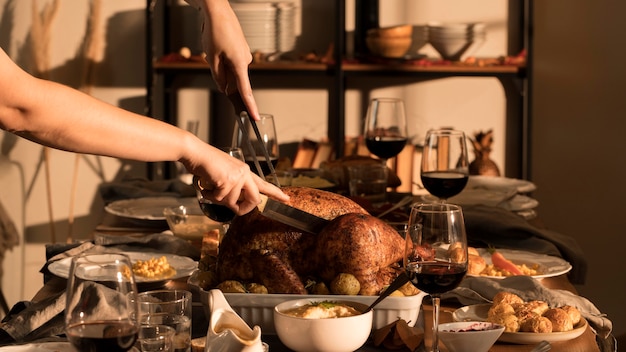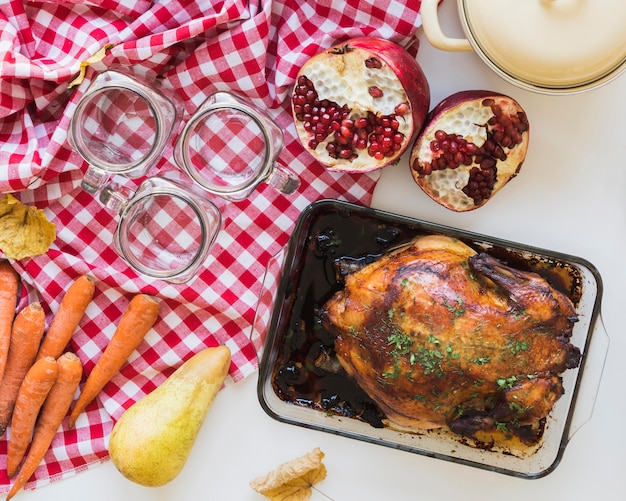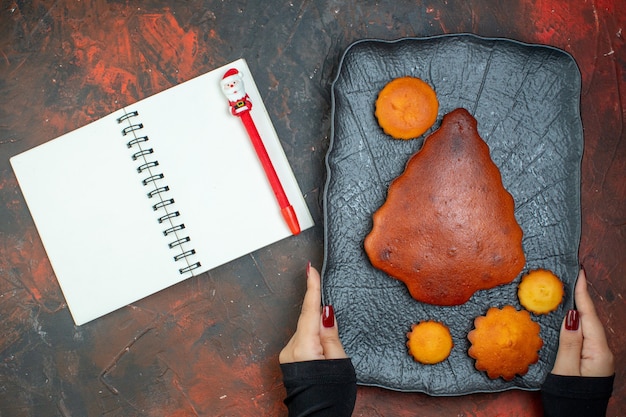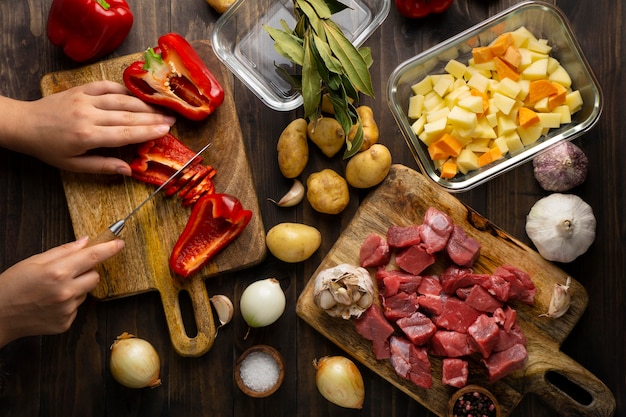Let's face it, cooking a turkey can be a bit daunting, especially if you're aiming for that perfect combination of crispy skin and juicy meat. But fear not, my fellow food enthusiasts, because I'm here to guide you through the wonders of convection oven turkey cooking. As a seasoned cook who's tackled countless holiday feasts, I've learned a thing or two about getting that turkey just right, and trust me, a convection oven is your secret weapon! It's like having a personal sous chef, circulating hot air around the bird for a truly exceptional result.
(Part 1) The Convection Oven Advantage: Why It's a Game Changer

Let's talk about why this type of oven is so fantastic for turkey. It's not just a fancy name; it actually makes a significant difference in the final product.
1. Faster Cooking Time: Get to the Feast Faster
One of the biggest perks of a convection oven is its speed. The circulating hot air cooks your turkey significantly faster than a traditional oven, which means you can get your delicious feast on the table quicker. Imagine saving precious time on a busy holiday – that's a win in my book! We're talking about a reduction in cooking time by about 25% to 30%.
2. Even Cooking: Say Goodbye to Dry Breast Meat
A convection oven ensures that your turkey cooks evenly, no more dry breast meat and raw thighs. The constant circulation of hot air guarantees that heat reaches every nook and cranny, resulting in a perfectly cooked bird with juicy and tender meat throughout. No more turkey roulette!
3. Crispy Skin: The Golden-Brown Perfection
Who doesn’t love that gloriously crispy, golden-brown skin? This is where convection ovens really shine. The circulating hot air dries the turkey's surface, which helps to crisp up the skin, creating a beautiful, irresistible finish. It's a sight (and a taste) that will leave everyone impressed.
(Part 2) Turkey Size Matters: Understanding the Weight Factor

Now, before we dive into cooking times, let's address the elephant in the room – the size of your turkey. Just like baking a cake, you can't cook a 10-pound bird the same way you would a 20-pounder. It's all about understanding the relationship between weight and cooking time.
1. Knowing Your Turkey's Weight: The First Step
First things first, you need to know the weight of your turkey. Most turkeys come with a weight label, but if you're unsure, a quick trip to the kitchen scale is all it takes. Once you have this crucial piece of information, we can move on to the fun part.
2. Weight-Based Cooking Time Guide: A Rough Estimate
Here's a general guide for convection oven turkey cooking times based on weight, but remember, these are just estimations. We'll get into more specific details later.
| turkey weight (lbs) | Convection oven cooking time (hours) |
|---|---|
| 8-12 | 2-3 |
| 12-16 | 3-4 |
| 16-20 | 4-5 |
This table provides a good starting point, but keep in mind that factors like whether you're stuffing the turkey, the size of your oven, and even the shape of your turkey can affect cooking time. We'll discuss those nuances in detail, so don't worry if you're feeling a bit overwhelmed!
(Part 3) Mastering the Art of Turkey Preparation: Setting Yourself Up for Success

Before you even think about popping that turkey into the oven, there are some essential preparation steps to take. Think of it as getting your kitchen ready for the big game.
1. Thawing Your Turkey: A Crucial Step
This might seem obvious, but thawing your turkey completely before cooking is absolutely crucial. A frozen turkey will take much longer to cook and won't cook evenly, leading to a less than stellar result. The safest and most recommended method is to thaw it slowly in the refrigerator. Allow enough time for thawing, as it takes about 24 hours for every 5 pounds of turkey. Don't try to rush it!
2. Brining for Extra Juiciness: A Secret to Tenderness
Now, let's talk about brining, a technique that involves soaking your turkey in a saltwater solution before cooking. This helps to lock in moisture, resulting in incredibly juicy and flavorful meat. I'm a huge fan of brining; it's like a magic trick that transforms a potentially dry bird into a culinary masterpiece.
For those new to brining, it's simple. You can create a basic brine using salt, water, and some herbs and spices. Or, if you'd rather skip the DIY, ready-made brining solutions are readily available in most grocery stores. Just soak your turkey in the brine for a few hours or even overnight, depending on the recipe. It's a bit of extra effort, but the results are well worth it.
3. Patting Dry for Crispy Skin: The Key to Golden-Brown Goodness
After thawing and brining (if you've chosen to go that route), it's essential to pat the turkey dry with paper towels. This helps to achieve that crispy skin we're all aiming for. Excess moisture will hinder the browning process, leaving you with a soggy skin – not a good look for a festive turkey!
4. Seasoning with Love: Infuse Flavor into Your Creation
Now for the fun part – seasoning! This is where you can unleash your creativity and experiment with different flavors. You can use a simple salt and pepper rub or go all out with your favorite herbs and spices. Personally, I love a mix of rosemary, thyme, garlic, and black pepper for a classic flavor. But feel free to get adventurous and see what you can create!
(Part 4) Convection Oven Settings and Tips: Navigating the Technicalities
Alright, we're getting down to the nuts and bolts. Convection ovens typically have two main settings: fan-only and fan-assisted with heat. For turkey, the fan-assisted with heat setting is your best bet, as it helps cook the turkey more evenly and achieve that beautiful, crispy skin we discussed earlier.
1. Preheating Your Oven: A Crucial First Step
Always preheat your convection oven to the appropriate temperature – usually around 325°F (165°C) – before putting the turkey in. This ensures the turkey cooks evenly from the start and gets that lovely golden-brown skin. Don't skip this step!
2. Using a Roasting Rack: Optimizing Air Circulation
Place your turkey on a roasting rack inside the oven, not directly on the pan. This allows for better airflow around the turkey, which promotes even cooking and prevents the skin from getting soggy. It's a simple trick that makes a big difference.
3. Adding Moisture: Preventing Dryness
A convection oven can sometimes dry out a turkey, so it's a good idea to add moisture. You can do this by adding a cup of water to the bottom of the roasting pan. As the turkey cooks, the water will turn into steam, helping to keep the meat moist and prevent it from drying out.
4. Checking for Doneness: The Thermometer is Your Friend
Don't just rely on the timing alone to determine if your turkey is done. Use a meat thermometer! Insert it into the thickest part of the thigh (not touching the bone) and make sure it reaches an internal temperature of 165°F (74°C).
If you're unsure, it's always better to be safe than sorry. Cook for a few minutes longer. Remember, you can always check again, but you can't uncook a turkey! And once the turkey reaches the desired temperature, remove it from the oven and let it rest for at least 15 minutes before carving. This allows the juices to redistribute, resulting in a more succulent and tender turkey.
(Part 5) Stuffing Considerations: The Great Debate
Ah, the age-old question: to stuff or not to stuff? It's a matter of personal preference, but stuffing the turkey does have an impact on cooking time. If you're stuffing your turkey, it will generally take a bit longer to cook, but the good news is that a convection oven helps to cook the stuffing more evenly.
1. Stuffed vs. Unstuffed: Cooking Time Adjustments
For a stuffed turkey, it's crucial to make sure the stuffing is cooked to 165°F (74°C). If you're concerned about undercooked stuffing, you can always cook it separately in a baking dish. It's a bit more work, but it ensures that the stuffing is cooked properly and you can avoid overcooking the turkey.
2. Stuffing Safety: Minimizing the Risk
When stuffing a turkey, do it right before placing it in the oven. This minimizes the time the stuffing spends at room temperature, reducing the risk of bacterial growth. And always use a meat thermometer to check the temperature of the stuffing, especially if you're cooking a large turkey.
(Part 6) Convection Oven Turkey Time Adjustments: Finessing the Process
Okay, now let's get specific about making those adjustments to your cooking time based on your turkey's size, whether you're stuffing or not, and even the quirks of your convection oven.
1. Size and Shape: The Impact of Dimensions
A larger turkey will naturally take longer to cook than a smaller one. Similarly, a turkey with a more compact shape might cook faster than a turkey with long legs and a wide breast. These factors can significantly impact the cooking time, so keep them in mind as you plan.
2. Stuffed vs. Unstuffed: Accounting for Filling
A stuffed turkey will take longer to cook than an unstuffed turkey because the stuffing needs time to heat through. A general rule of thumb is to add 30 to 45 minutes to the total cooking time for a stuffed turkey. Remember to check the internal temperature of both the turkey and the stuffing to ensure they are cooked thoroughly.
3. Oven Variations: Finding Your Oven's Sweet Spot
Every convection oven is unique. Some might cook a bit hotter or circulate air differently, which can affect cooking times. You might need to experiment a bit to find the ideal settings and cooking time for your specific oven. Don't be afraid to try different things to see what works best.
4. Temperature Monitoring: A Constant Vigil
It's important to keep a close eye on the turkey's temperature during cooking. Use a meat thermometer to check the internal temperature of the thigh at regular intervals and adjust the cooking time as needed. It's better to be safe than sorry, so always err on the side of caution and cook a bit longer if needed.
(Part 7) Doneness and Resting Time: Ensuring a Juicy, Tender Outcome
You've followed all the steps, your turkey has been cooking, and it looks absolutely glorious. But how do you know for sure it's done? It's not just about the time; it's about making sure your turkey is cooked through and safe to eat.
1. Checking for Doneness: The Importance of a Thermometer
The most accurate way to determine if your turkey is done is to use a meat thermometer. Insert it into the thickest part of the thigh, making sure not to touch the bone. The internal temperature should reach 165°F (74°C). If you're unsure, always err on the side of caution and cook for a few minutes longer. Remember, you can always check again, but you can't uncook a turkey!
2. Signs of Doneness: Visual Clues
While a thermometer is the most reliable method, there are a few other visual cues that can indicate doneness. The juices should run clear, not pink, when you pierce the thickest part of the thigh with a knife. Also, the skin should be golden brown and crispy. But again, always rely on the thermometer for final confirmation.
3. Resting Time: Allowing Juices to Redistribute
Once the turkey is cooked, don't rush to carve it. Allow the turkey to rest for at least 15 minutes before carving. This lets the juices redistribute, resulting in a more succulent and tender turkey. Cover the turkey loosely with foil to keep it warm while it rests. It's a small step, but it makes a big difference in the final outcome.
(Part 8) FAQs: Convection Oven Turkey Cooking
Let's address some common questions that people have about cooking a turkey in a convection oven.
1. Can I use a traditional turkey roasting pan in a convection oven?
Absolutely! A traditional roasting pan works perfectly in a convection oven. Just ensure there's enough space around the turkey for proper air circulation. If you're using a smaller oven, you might need to adjust the cooking time slightly.
2. Should I lower the oven temperature when using convection?
Generally, you don't need to lower the oven temperature when using convection. The forced air helps to cook the turkey faster and more evenly. However, you might need to make slight adjustments depending on your specific oven and the turkey's size. It's always a good idea to monitor the temperature and make adjustments as needed.
3. Can I use a digital thermometer for convection oven turkey cooking?
Yes, you can! Digital thermometers are great for convection oven turkey cooking because they provide instant and accurate readings. Just make sure to insert the thermometer into the thickest part of the thigh (not touching the bone) and keep an eye on the temperature as the turkey cooks. It's a handy tool to ensure you're getting a perfectly cooked turkey.
4. Can I cook a turkey breast in a convection oven?
You certainly can! Cooking a turkey breast in a convection oven is a great way to ensure a juicy and flavorful result. The faster cooking time and even heat distribution are ideal for smaller cuts of turkey. Just follow the same general guidelines for cooking time and temperature, but make sure to check the internal temperature of the turkey breast using a meat thermometer.
5. Can I use a convection oven to cook a smaller turkey?
Yes, absolutely! A convection oven is perfect for cooking smaller turkeys. The faster cooking time and even heat distribution are ideal for smaller birds. Just follow the same general guidelines for cooking time and temperature, and remember to check the internal temperature using a meat thermometer.
There you have it, my friends! The ultimate guide to convection oven turkey cooking. Remember, practice makes perfect, so don't be afraid to experiment and find what works best for you. With this guide in your arsenal, you'll be serving up a beautifully golden-brown, juicy, and tender turkey that will make your family and friends sing your praises. Happy cooking!
Everyone is watching

Perfect Rice Every Time: The Ultimate Guide to Cooking Rice
Cooking TipsAs a self-proclaimed foodie, I've always been a bit obsessed with rice. It's the foundation of countless cuisi...

Ultimate Guide to Cooking the Perfect Thanksgiving Turkey
Cooking TipsThanksgiving. Just the word conjures up images of overflowing tables laden with delicious food, the scent of r...

The Ultimate Guide to Cooking Asparagus: Tips, Techniques, and Recipes
Cooking TipsAsparagus. The mere mention of this spring delicacy conjures up images of vibrant green spears, crisp and burs...

Can You Cook Spaghetti with Gasoline? (The Shocking Truth)
Cooking TipsWe've all seen those crazy internet trends. You know, the ones that make you wonder, "Did someone actually try...

Chorizo and Eggs Recipe: The Ultimate Guide
Cooking TipsRight, let’s talk about chorizo and eggs. You know, that classic Spanish dish that's always a winner. It's th...
